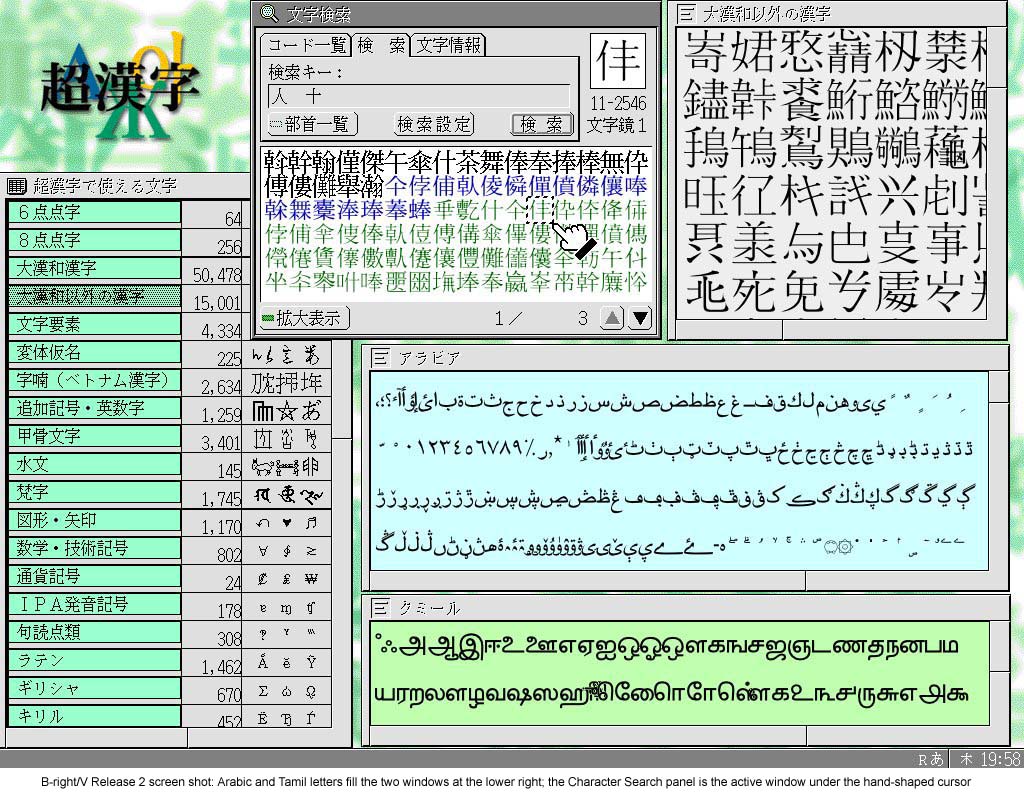


Personal Media Corporation has announced that it will begin marketing in the middle of November 1999 a new version of its operating system for IBM-PC/AT compatibles that can handle all known kanji (Chinese characters) for writing the Japanese language. The new version of the company's BTRON3-specification operating system, B-right/V Release 2 (B-right/V R2; this was previously given the tentative name of "3B/V" and is also referred to as "Cho Kanji," or Ultra-Kanji by the company), will also include a large number of other character sets for writing various Asian languages of the past and present, plus many new symbols. The total number of characters included in the new operating system is 128,450, which is double the number of characters proposed for standardization by the Unicode Consortium.
In order to handle this large number of kanji, B-right/V R2 will include a special search utility. This utility will allow users to find kanji using their readings and character codes, plus alternative characters and related characters. The utility will also make it possible to find kanji by conducting searches based on their constituent parts, which are known as radicals or significants. Accordingly, in spite of the large number of kanji, which will be in excess of 65,000 characters, users are expected to be able to easily find the characters that they wish to write in their documents.
The B-right/V R2 operating system will be marketed without a fixed price, although it is expected to sell at around 10,000 yen in stores, Personal Media said. The company is hoping to sell 300,000 copies of the new operating system, which is six times the number it said it hoped to sell with B-right/V R1 announced in July 1998. Obviously, Personal Media is expecting a very positive response to it's latest offering from personal computer users throughout Japan.
The character set for B-right/V R2 is as follows:
Developers interested in writing application software for the B-right/V R2 operating system can download a free development environment from Personal Media Corporation's Web site (see below). However, the development environment in question is Japanese language-based, so development teams should include bilingual software engineers and/or technical coordinators.
Personal Media Corporation got its home page for B-right/V developers up and running in September (click here to access the Japanese-language home page). B-right/V application developers can download free of charge from this home page the "B-right/V GNU-based Software Developer's Kit" (BV-GSDK), which is based on the on the popular GNU soft development kit created by the Free Software Foundation headed by Richard Stallman.
The home page has--as can be expected!--a liability denial statement, plus five links, which are as follows: (1) Development Environment (BV-GSDK can be downloaded from here), (2) Specification (specifications for developing B-right/V applications), (3) Technical Information (useful technical information for B-right/V application development), (4) Free Software Link Collection (currently empty), and (5) Mailing List Information (a mailing list for developers using BV-GSDK).
It should be noted that Metrowerks Inc.'s CodeWarrior development environment is supposed to become the standard development environment for ITRON- and BTRON-specification operating systems at some time in the future. Metrowerks has yet to announce any release date. However, the president of Metrowerks Japanese subsidiary, Mr. John Cheuck, gave a presentation titled "CodeWarrior: Next Generation Development Tools for ITRON" at the ITRON Open Seminar, which was recently held on June 30 and July 1 in the Hitotsubashi section of Tokyo.
The annual U.S. meeting of ITRON enthusiasts, officially titled "ITRON International Meeting '99," took place at the Hyatt Sainte Claire Hotel in San Jose, California, on September 29, 1999. The meeting, which was sponsored by the TRON Association's ITRON Technical Committee in cooperation with The Open Group with support from the Japan External Trade Organization (JETRO), was held to coincide with Embedded Systems Conference '99, which took place in the nearby San Jose Convention Center.
This year's meeting featured a large number of foreign speakers, which seems to indicate there is considerable interest in the ITRON subproject outside Japan. It also featured presentations by heavyweight Japanese speakers, such as Mr. Koji Sato of Toyota Motor Corporation. Toyota, as previously reported on TRON Web, has decided make micro-ITRON its standard real-time operating system for use in some of the automobiles it manufactures. The recently announced Land Cruiser Prado uses 32-bit microprocessors and micro-ITRON kernels to power programs for engine control and actuating the brakes and air bags.
It is also interesting to note that Elmic Systems Inc., which recently announced a micro-ITRON-based environment ("Accel-µ") for "speeding up" Microsoft Corporation's Windows CE operating system, also gave a presentation. It will be interesting to see exactly how much interest/enthusiasm will be generated by this product in the U.S.
For those interested in TRON Project history, it should be pointed out that in the late 1980s a company called Micronics Co. developed a version of ITRON that ran in conjunction with the special version of MS-DOS 3.3 that ran on NEC Corporation's PC-9801 series hardware. Called "PC-TRON," the goal at that time was to speed up MS-DOS and make it multitask.
The Program of ITRON International Meeting '99 was as follows:
TRONSHOW 2000 will be held at the Tokyo Design Center in Gotanda, Tokyo, at the beginning of December. The show will run from Thursday, December 2 through Saturday, December 4. Plans for the TRON Project in the 21st century will be unveiled at the show, and there will be exhibits of products based on the TRON Architecture. The newly announced version of the B-right/V operating system with an unabridged kanji character set is expected to draw considerable interest from visitors at the show.
The Tokyo Design Center is approximately a two minute walk from JR Gotanda Station, which is one of the stations along the JR Yamanote Line in Tokyo. There is also bus and subway service to JR Gotanda Station, so traveling from all points in the Tokyo area should be no problem for those planning to attend the show.